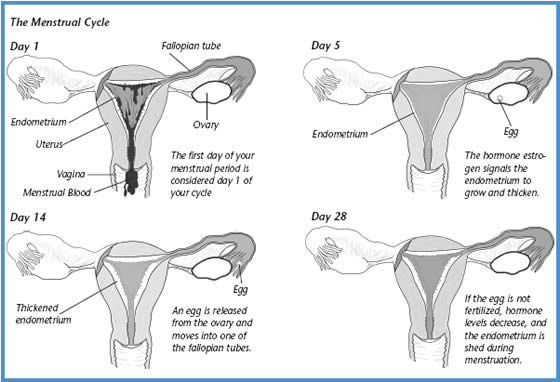
Image Description
Menstruation is the term given to the periodic discharge of blood, tissue, fluid and mucus from the reproductive organsn (vaginal) of sexually mature females.
The menstrual flow usually lasts from 3 - 7 days each month and is caused by a sudden reduction in the hormones estrogen and progesterone. Factors like nutrition, stress, exercise, and belief systems can all influence how the hormones work and what we experience during our menstrual cycles.
Menstruation is the most visible phase of the menstrual cycle. Menstrual cycles are counted from the first day of menstrual bleeding, because the onset of menstruation corresponds closely with the hormonal cycle. During pregnancy and for some time after childbirth, menstruation is normally suspended; this state is known as amenorrhoea, i.e. absence of the menstrual cycle. If menstruation has not resumed, fertility is low during lactation. The average length of postpartum amenorrhoea is longer when certain breastfeeding practices are followed; this may be done intentionally as birth control.
The Menstruation Story

Image Description
An average menstrual cycle lasts 28-30 days, counting from the first day of one period to the first day of the next. Normal cycles can vary from 21 to 35 days.
Each month, after day 5 of your cycle, the lining of the uterus (endometrium) begins to grow and thicken. If a woman were to become pregnant, that extra-thick lining would help to nourish the developing fetus (a baby growing in the woman's uterus).
Around cycle day 14, an egg is released from one of your ovaries. This is called ovulation. The egg moves into one of the two fallopian tubes connected to the uterus. If the egg is fertilized by a man's sperm, it moves into the uterus, where it attaches to the lining, and begins to grow into a fetus.
Around cycle day 28, if an egg is not fertilized, the endometrium is shed by bleeding. The menstrual blood (a mix of blood and tissue from the inside of the uterus) flows from the uterus through the cervix into the vagina and out of the body. This bleeding is your menstrual period. Your period may last for 3-5 days. Some last as long as 7 days. The process then starts again in the next cycle.
You should consult your health care provider if....
You haven't started menstruating by age 16
Your period suddenly stops
You bleed excessively, or for more days than usual
You suddenly feel sick after using tampons
You bleed between periods
You have severe pain during your period
Premenstrual syndrome is a group of symptoms that start one to two weeks before your period. Most women have at least some symptoms of Premenstrual, and the symptoms go away after their periods start. For some women, the symptoms are severe enough to interfere with their lives.
Common PMS symptoms as following;
1. Breast swelling and tenderness
2. Acne
3. Bloating and weight gain
4. Pain - headache or joint pain
5. Food cravings
6. Irritability, mood swings, crying spells, depression
Most women use something to absorb or catch their menses. There are a number of different methods available.
Disposable items:
1. Sanitary napkins (Sanitary towels ) or pads — Somewhat rectangular pieces of material worn in the underwear to absorb menstrual flow, with "wings" pieces that fold around the panties, an adhesive backing to hold the pad in place. Disposable pads may contain wood pulp or gel products, usually with a plastic lining and bleached. Some sanitary napkins, particularly older styles, are held in place by a belt-like apparatus, instead of adhesive or wings.
2. Tampons — Disposable cylinders of treated rayon/cotton blends or all-cotton fleece, usually bleached, that are inserted into the vagina to absorb menstrual flow.
3. Padettes — Disposable wads of treated rayon/cotton blend fleece that are placed within the inner labia to absorb menstrual flow.
4. Disposable menstrual cups — A firm, flexible cup-shaped device worn inside the vagina to catch menstrual flow. Disposable cups are made of soft plastic.
Resources | Sitemap
The web page was made with Mobirise